
 Last
Updated 21 July-2001
Last
Updated 21 July-2001Engine Tuning Pt I (let it breath)
A stock KR is pretty quick but the top end can be improved by allowing the engine to breath. Though the engine only runs 28 mm carbs which ultimately limit performance (RGV run 32 or 34 mm Carbs and RS125, RS250 and TZ250 run 38 mm carbs - Carb area KR=615 sq mm, RGV=804mm or 907sq mm, TZ=1134 sq mm) the top end is initially limited by the airbox which can't flow enought air at peak revs, and by the filter which restricts flow (You aren't allowed to change the carbs so you need to do as much as possible to derestrict flow on the inlet side, otherwise a lot of your porting work will be wasted). To allow the engine to breath at high revs I have seen various modifications made to the airbox which range from cutting holes in the lid to throwing the lid away. I am not sure what is the best thing to do here, so as I don't like destructive modifications I have lifted the lid at the front by 25mm using a couple of ally spacers and longer screws. This is OK but the air box then picks up air from the area above the carbs just behind the rad and engine, i.e. an area containing hot air. To stop this hot air from getting into the airbox I run a heat shield. Basically a plate that sits on top of the frame and covers the area from the air box to the head stock. Two strokes love cold air so I feed cold air from the front of the bike into the area between the heat shield and the tank. I run the air filter if it is wet or dusty. With the lid raised you can see the air filter. To see how much it restricts flow - rev the engine and watch the filter get sucked down into the airbox.
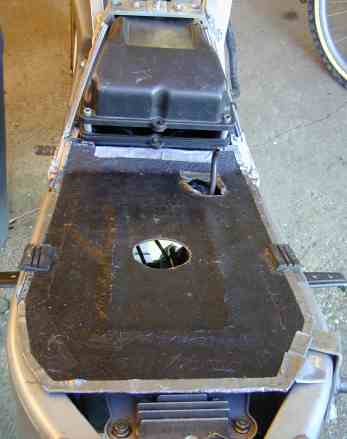

I had to increase the main jet size to 147 jets (I use jets marked as RD jets which are slightly different to Kehin jets - I assume, but don't know for sure that a 147 RD jet is the same as a Kehin jet?) and raise the needle 1 notch (Allens on 01949-8367333 are the place to go for jets and carb advice). Do not force feed (pressurise) the airbox as you will probably mess up the carburation. On the FCC ram airboxes I have seen, the carb is in the airbox so it is subject to all the air pressure changes caused by pressurising an airbox (see the piccy on the RS125 page). I run standard pipes and TZ cans (Dennis Trollope £25 each) and the bike carburates nicely - with a good part throttle response. Later mods will be to improve the ducting from the front
The above was the old set up. The new set up replaces the old corrugated ally tube with a smooth fibre glass tube running straight into the airbox. If you blew down the old tube you couldn't feel anything at the other end. The new smooth tube flows much better and you can feel the air at the far end. Airbox has a wire gauze instead of a filter simply to catch bits of gravel (they used to get trapped in the corrugations). The lid has the stock holes at the back to stop over pressurisation. Had to drop the rad a bit to make room for air scoop + pipe. I also have a new jetting table . I have also started work on sourcing and fitting a set of 35mm KR1-R carbs
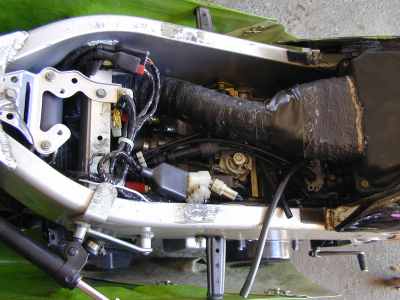
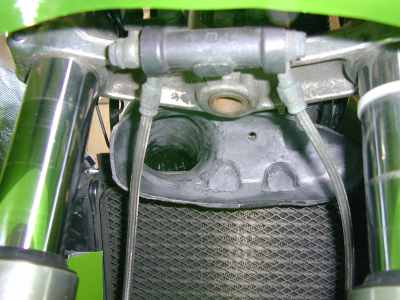
MK II Air Box first proper Test - Tested at Mallory today.
Interesting as I think I have found the edge on jetting. Humidity was
about 58% to 35%, temperature 21.5° to 23°C and pressure 1005 to 1007 mB.
Running a 135 main jet I was able to redline along the backstraight
on 15/43 (I normally run 15/45). Only problem was that the bike was
getting hot very quickly and smelt hot when I came in. First session
I did on 15/44 then second on 15/43 between sessions the humidity
dropped from 55% to 35%. First session I did about 5 laps before the
temperature started going over 70° C ( I run a £23 Scitsui temp
gauge instead of the stock gauge - Dennis Trollope). Bike easily
pulled 6th down both straights and over revved on the back straight.
As I was running in new rings and little end I knocked the session
on the head. Next session I ran 15/43 and the bike still went into
the red on the back straight. The engine was cutting out on both
straights on 5th to 6th gear changes. After 3 laps came in as the
temperature had gone over 70° C. Engine again smelt very hot (did a
plug chop and plugs were spot on a nice digestive brown). Though the plugs
looked ok decided to change up to 140 mains for the last session .
The cutting out between gears has gone but the bike would now not
rev out in 6th. Laps were low 57 not fast but as I normally do 59 -
60 on a practice day I was quite happy, not really trying so can go
faster - under race conditions I normally take 3 to 4 seconds of f
my practice times.
From a conversation with Graham File we think
the stutter when changing gear might be detonation as the mixture
goes weak as you close and open the throttle ( I will strip it down
and check). Going to a bigger jet (140) solved the problem. Equally
lifting the needle one more clip might have the same effect. I also
think a slightly better cooling system will help. The fuel on a two
stroke helps cool the cylinder. As the mixture goes in the cylinder
it vapourises and extracts heat out of the cylinder and piston it
also expands. The more it expands the less mixture gets sucked in so
the engine starts going weak and detonating. If the standard cooling
system plus the fuel doesn't cool the engine you can either richen the
mixture, put more fuel into the system to cool it and thus restore
equilibrium but you will no longer be running an optimal fuel/air mixture.
Or you can improve the cooling on the bike, fit a bigger rad - this
will then allow you to use the optimal mix. The Radiator on a KR is
to small to cool a tuned engine on a hot day - so it looks like I
need to source a bigger rad by July 15 and probably for Snetterton
on 23 Sept. Anglesey shouldn't be a problem as it is a slow circuit
and Cadwell again is not flat out in the same way as Mallory. Also
air temperature there always seems lower - could be the trees and
position? ( 20 June 2001)
Stripped the top end today. Very slight detonation marks, about 5 or 6, on the left hand cylinder head and a few on the piston crown. Rest looked ok with no signs of nipping up or anything. Probably be ok for Mallory it is just me being paranoid? (21 June 2001)
Decided the problem with the stutter might be the airbox over pressurising when I close the throttle. If this is so the air scoop must be working so I think I might try and run a full RAM air system. I will set this up after Mallory as I don't have time pre-race to implement a fix. Solution is to run the two breathers of each carb into the airbox grommets with a 6mm I/D will do the job. The more difficult problem is pressurising the fuel tank. There is no easy solution so I might have to add an extra external breather. From this a pipe (6mm I/D) will be fed down into the airbox. It will serve two purposes the first being to get a decent sized breather on the tank and the second to allow the tank to run at airbox pressure. More later (2 July 2001)
Modified the airbox so that the carbs run at airbox pressure. Hopefully this will go some way to stopping the stutter. The fuel tank is not at airbox pressure but I vent the overflow into the airbox so hopefully the tank will get some extra air? Air box still has the original intakes open so isn't pressurised.
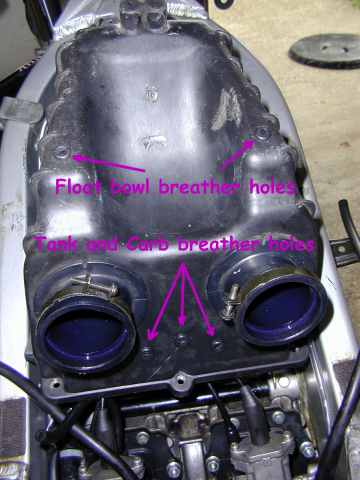
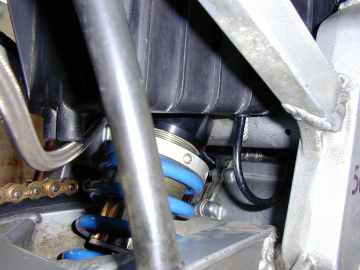
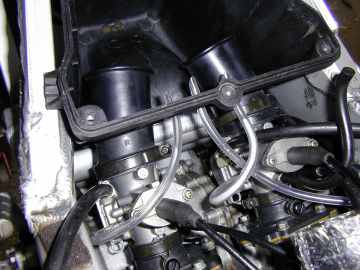
Following the first use of the airbox with breathers on, at Mallory on 15 July 2001, the problem with the stutter had gone. Can't say it is fixed as I could have got away with 138 jets on the day - ran 140's and previously going up in jet size had fixed the problem. Still it didn't appear to do the bike any harm. (17 July 2001)
Next step will be to try a full RAM air at Cadwell - probably do this in stages by reducing the size of the stock airbox airintake by taping them up. More after Cadwell (21/7/2001)
Return to KR1-S FORUM Return to Main Index
This document maintained by mark@teamsparrow.fsnet.co.uk.
Material
Copyright © 2000 Mark
Jordan